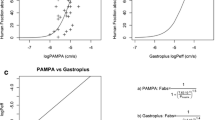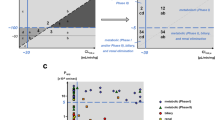Abstract
Purpose
To assess the utility of Extended Clearance Classification System (ECCS) in understanding absorption, distribution, metabolism, and elimination (ADME) attributes and enabling victim drug-drug interaction (DDI) predictions.
Methods
A database of 368 drugs with relevant ADME parameters, main metabolizing enzymes, uptake transporters, efflux transporters, and highest change in exposure (%AUC) in presence of inhibitors was developed using published literature. Drugs were characterized according to ECCS using ionization, molecular weight and estimated permeability.
Results
Analyses suggested that ECCS class 1A drugs are well absorbed and systemic clearance is determined by metabolism mediated by CYP2C, esterases, and UGTs. For class 1B drugs, oral absorption is high and the predominant clearance mechanism is hepatic uptake mediated by OATP transporters. High permeability neutral/basic drugs (class 2) showed high oral absorption, with metabolism mediated generally by CYP3A, CYP2D6 and UGTs as the predominant clearance mechanism. Class 3A/4 drugs showed moderate absorption with dominant renal clearance involving OAT/OCT2 transporters. Class 3B drugs showed low to moderate absorption with hepatic uptake (OATPs) and/or renal clearance as primary clearance mechanisms. The highest DDI risk is typically seen with class 2/1B/3B compounds manifested by inhibition of either CYP metabolism or active hepatic uptake. Class 2 showed a wider range in AUC change likely due to a variety of enzymes involved. DDI risk for class 3A/4 is small and associated with inhibition of renal transporters.
Conclusions
ECCS provides a framework to project ADME profiles and further enables prediction of victim DDI liabilities in drug discovery and development.




Similar content being viewed by others
Abbreviations
- BCRP:
-
Breast cancer resistant protein
- CYP:
-
Cytochrome P-450
- DDIs:
-
Drug-drug interactions
- ECCS:
-
Extended clearance classification system
- EMA:
-
European Medicines Agency
- FDA:
-
Food and Drug Administration
- NME:
-
New molecular entity
- OAT:
-
Organic anion transporter
- OATP:
-
Organic anion transporting polypeptide
- OCT:
-
Organic cation transporter
- P-gp:
-
P-glycoprotein
- PK:
-
Pharmacokinetics
- UGT:
-
Uridine 5’-diphospho-glucuronosyltransferase
References
Beaumont K, Smith DA. Does human pharmacokinetic prediction add significant value to compound selection in drug discovery research? Curr Opin Drug Discov Devel. 2009;12(1):61–71.
Mager DE. Quantitative structure-pharmacokinetic/pharmacodynamic relationships. Adv Drug Deliv Rev. 2006;58(12–13):1326–56.
Rostami-Hodjegan A, Tucker GT. Simulation and prediction of in vivo drug metabolism in human populations from in vitro data. Nat Rev. 2007;6(2):140–8.
van de Waterbeemd H, Gifford E. ADMET in silico modelling: towards prediction paradise? Nat Rev. 2003;2(3):192–204.
van De Waterbeemd H, Smith DA, Beaumont K, Walker DK. Property-based design: optimization of drug absorption and pharmacokinetics. J Med Chem. 2001;44(9):1313–33.
Varma MV, Khandavilli S, Ashokraj Y, Jain A, Dhanikula A, Sood A, et al. Biopharmaceutic classification system: a scientific framework for pharmacokinetic optimization in drug research. Curr Drug Metab. 2004;5(5):375–88.
Varma MV, Steyn SJ, Allerton C, El-Kattan AF. Predicting clearance mechanism in drug discovery: extended clearance classification system (ECCS). Pharm Res. 2015;32(12):3785–802.
Mullins ME, Horowitz BZ, Linden DH, Smith GW, Norton RL, Stump J. Life-threatening interaction of mibefradil and beta-blockers with dihydropyridine calcium channel blockers. JAMA. 1998;280(2):157–8.
Tamraz B, Fukushima H, Wolfe AR, Kaspera R, Totah RA, Floyd JS, et al. OATP1B1-related drug-drug and drug-gene interactions as potential risk factors for cerivastatin-induced rhabdomyolysis. Pharmacogenet Genomics. 2013;23(7):355–64.
Bjornsson TD, Callaghan JT, Einolf HJ, Fischer V, Gan L, Grimm S, et al. The conduct of in vitro and in vivo drug-drug interaction studies: a Pharmaceutical Research and Manufacturers of America (PhRMA) perspective. Drug Metab Dispos Biol Fate Chem. 2003;31(7):815–32.
Zhang H, Cui D, Wang B, Han YH, Balimane P, Yang Z, et al. Pharmacokinetic drug interactions involving 17alpha-ethinylestradiol: a new look at an old drug. Clin Pharmacokinet. 2007;46(2):133–57.
Bloomer J, Derimanov G, Dumont E, Ellens H, Matheny C. Optimizing the in vitro and clinical assessment of drug interaction risk by understanding co-medications in patient populations. Expert Opin Drug Metab Toxicol. 2013;9(6):737–51.
FDA. Drug interaction studies - study design, data analysis, implications for dosing, and labeling recommendations. Center for Drug Evaluation and Research (CDER); 2012.
EMA. Guideline on the investigation of drug interactions. Committee for Human Medicinal Products (CHMP); 2012.
Williams JA, Hyland R, Jones BC, Smith DA, Hurst S, Goosen TC, et al. Drug-drug interactions for UDP-glucuronosyltransferase substrates: a pharmacokinetic explanation for typically observed low exposure (AUCi/AUC) ratios. Drug Metab Dispos. 2004;32(11):1201–8.
Kiang TK, Ensom MH, Chang TK. UDP-glucuronosyltransferases and clinical drug-drug interactions. Pharmacol Ther. 2005;106(1):97–132.
International Transporter C, Giacomini KM, Huang SM, Tweedie DJ, Benet LZ, Brouwer KL, et al. Membrane transporters in drug development. Nat Rev Drug Discov. 2010;9(3):215–36.
Watanabe T, Kusuhara H, Sugiyama Y. Application of physiologically based pharmacokinetic modeling and clearance concept to drugs showing transporter-mediated distribution and clearance in humans. J Pharmacokinet Pharmacodyn. 2010;37(6):575–90.
Maeda K, Ikeda Y, Fujita T, Yoshida K, Azuma Y, Haruyama Y, et al. Identification of the rate-determining process in the hepatic clearance of atorvastatin in a clinical cassette microdosing study. Clin Pharmacol Ther. 2011;90(4):575–81.
Varma MV, Steyn SJ, Allerton C, El-Kattan AF. Predicting clearance mechanism in drug discovery: extended clearance classification system (ECCS). Pharma Res. 2015.
Varma MV, Obach RS, Rotter C, Miller HR, Chang G, Steyn SJ, et al. Physicochemical space for optimum oral bioavailability: contribution of human intestinal absorption and first-pass elimination. J Med Chem. 2010;53(3):1098–108.
Lombardo F, Obach RS, Varma MV, Stringer R, Berellini G. Clearance mechanism assignment and total clearance prediction in human based upon in silico models. J Med Chem. 2014;57(10):4397–405.
Amidon GL, Lennernas H, Shah VP, Crison JR. A theoretical basis for a biopharmaceutic drug classification: the correlation of in vitro drug product dissolution and in vivo bioavailability. Pharm Res. 1995;12(3):413–20.
Thomas VH, Bhattachar S, Hitchingham L, Zocharski P, Naath M, Surendran N, et al. The road map to oral bioavailability: an industrial perspective. Expert Opin Drug Metab Toxicol. 2006;2(4):591–608.
Smith DA, Beaumont K, Maurer TS, Di L. Volume of distribution in drug design. J Med Chem. 2015;58(15):5691–8.
Varma MV, Gardner I, Steyn SJ, Nkansah P, Rotter CJ, Whitney-Pickett C, et al. pH-Dependent solubility and permeability criteria for provisional biopharmaceutics classification (BCS and BDDCS) in early drug discovery. Mol Pharm. 2012;9(5):1199–212.
Lewis DF. Modelling human cytochromes P450 for evaluating drug metabolism: an update. Drug Metabol Drug Interact. 2000;16(4):307–24.
Feng B, Hurst S, Lu Y, Varma MV, Rotter CJ, El-Kattan A, et al. Quantitative prediction of renal transporter-mediated clinical drug-drug interactions. Mol Pharm. 2013;10(11):4207–15.
Feng B, LaPerle JL, Chang G, Varma MV. Renal clearance in drug discovery and development: molecular descriptors, drug transporters and disease state. Expert Opin Drug Metab Toxicol. 2010;6(8):939–52.
Varma MV, Feng B, Obach RS, Troutman MD, Chupka J, Miller HR, et al. Physicochemical determinants of human renal clearance. J Med Chem. 2009;52(15):4844–52.
Varma MV, Pang KS, Isoherranen N, Zhao P. Dealing with the complex drug-drug interactions: towards mechanistic models. Biopharm Drug Dispos. 2015;36(2):71–92.
Varma MV, Bi YA, Kimoto E, Lin J. Quantitative prediction of transporter- and enzyme-mediated clinical drug-drug interactions of organic anion-transporting polypeptide 1B1 substrates using a mechanistic net-effect model. J Pharmacol Exp Ther. 2014;351(1):214–23.
Di L, Feng B, Goosen TC, Lai Y, Steyn SJ, Varma MV, et al. A perspective on the prediction of drug pharmacokinetics and disposition in drug research and development. Drug Metab Dispos Biol Fate Chem. 2013;41(12):1975–93.
Granfors MT, Backman JT, Neuvonen M, Ahonen J, Neuvonen PJ. Fluvoxamine drastically increases concentrations and effects of tizanidine: a potentially hazardous interaction. Clin Pharmacol Ther. 2004;75(4):331–41.
Neuvonen PJ, Jalava KM. Itraconazole drastically increases plasma concentrations of lovastatin and lovastatin acid. Clin Pharmacol Ther. 1996;60(1):54–61.
Lilja JJ, Kivisto KT, Neuvonen PJ. Grapefruit juice-simvastatin interaction: effect on serum concentrations of simvastatin, simvastatin acid, and HMG-CoA reductase inhibitors. Clin Pharmacol Ther. 1998;64(5):477–83.
Lindamood C, Ortiz S, Shaw A, Rackley R, Gorski JC. Effects of commonly administered agents and genetics on nebivolol pharmacokinetics: drug-drug interaction studies. J Clin Pharmacol. 2011;51(4):575–85.
Bosilkovska M, Samer CF, Deglon J, Rebsamen M, Staub C, Dayer P, et al. Geneva cocktail for cytochrome p450 and P-glycoprotein activity assessment using dried blood spots. Clin Pharmacol Ther. 2014;96(3):349–59.
Klatt S, Fromm MF, Konig J. The influence of oral antidiabetic drugs on cellular drug uptake mediated by hepatic OATP family members. Basic Clin Pharmacol Toxicol. 2013;112(4):244–50.
VandenBrink BM, Foti RS, Rock DA, Wienkers LC, Wahlstrom JL. Evaluation of CYP2C8 inhibition in vitro: utility of montelukast as a selective CYP2C8 probe substrate. Drug Metab Dispos Biol Fate Chem. 2011;39(9):1546–54.
Aquilante CL, Kosmiski LA, Bourne DW, Bushman LR, Daily EB, Hammond KP, et al. Impact of the CYP2C8 *3 polymorphism on the drug-drug interaction between gemfibrozil and pioglitazone. Br J Clin Pharmacol. 2013;75(1):217–26.
Regazzi MB, Iacona I, Campana C, Raddato V, Lesi C, Perani G, et al. Altered disposition of pravastatin following concomitant drug therapy with cyclosporin A in transplant recipients. Transplant Proc. 1993;25(4):2732–4.
Benet LZ, Broccatelli F, Oprea TI. BDDCS applied to over 900 drugs. AAPS J. 2011;13(4):519–47.
Tapaninen T, Backman JT, Kurkinen KJ, Neuvonen PJ, Niemi M. Itraconazole, a P-glycoprotein and CYP3A4 inhibitor, markedly raises the plasma concentrations and enhances the renin-inhibiting effect of aliskiren. J Clin Pharmacol. 2011;51(3):359–67.
Igel S, Drescher S, Murdter T, Hofmann U, Heinkele G, Tegude H, et al. Increased absorption of digoxin from the human jejunum due to inhibition of intestinal transporter-mediated efflux. Clin Pharmacokinet. 2007;46(9):777–85.
Hartter S, Sennewald R, Nehmiz G, Reilly P. Oral bioavailability of dabigatran etexilate (Pradaxa((R))) after co-medication with verapamil in healthy subjects. Br J Clin Pharmacol. 2013;75(4):1053–62.
Tachibana T, Kato M, Takano J, Sugiyama Y. Predicting drug-drug interactions involving the inhibition of intestinal CYP3A4 and P-glycoprotein. Curr Drug Metab. 2010;11(9):762–77.
Shugarts S, Benet LZ. The role of transporters in the pharmacokinetics of orally administered drugs. Pharm Res. 2009;26(9):2039–54.
Cho HJ, Kim JE, Kim DD, Yoon IS. In vitro-in vivo extrapolation (IVIVE) for predicting human intestinal absorption and first-pass elimination of drugs: principles and applications. Drug Dev Ind Pharm. 2014;40(8):989–98.
Hisaka A, Nakamura M, Tsukihashi A, Koh S, Suzuki H. Assessment of intestinal availability (FG) of substrate drugs of cytochrome p450s by analyzing changes in pharmacokinetic properties caused by drug-drug interactions. Drug Metab Dispos Biol Fate Chem. 2014;42(10):1640–5.
Yamada A, Maeda K, Kamiyama E, Sugiyama D, Kondo T, Shiroyanagi Y, et al. Multiple human isoforms of drug transporters contribute to the hepatic and renal transport of olmesartan, a selective antagonist of the angiotensin II AT1-receptor. Drug Metab Dispos Biol Fate Chem. 2007;35(12):2166–76.
Zhou L, Chen X, Gu Y, Liang J. Transport characteristics of candesartan in human intestinal Caco-2 cell line. Biopharm Drug Dispos. 2009;30(5):259–64.
MacFadyen RJ, Meredith PA, Elliott HL. Enalapril clinical pharmacokinetics and pharmacokinetic-pharmacodynamic relationships. An overview. Clin Pharmacokinet. 1993;25(4):274–82.
Shionoiri H, Naruse M, Minamisawa K, Ueda S, Himeno H, Hiroto S, et al. Fosinopril. Clinical pharmacokinetics and clinical potential. Clin Pharmacokinet. 1997;32(6):460–80.
Tachibana T, Kato M, Sugiyama Y. Prediction of nonlinear intestinal absorption of CYP3A4 and P-glycoprotein substrates from their in vitro Km values. Pharm Res. 2012;29(3):651–68.
Varma MV, Ambler CM, Ullah M, Rotter CJ, Sun H, Litchfield J, et al. Targeting intestinal transporters for optimizing oral drug absorption. Curr Drug Metab. 2010;11(9):730–42.
Morgan P, Van Der Graaf PH, Arrowsmith J, Feltner DE, Drummond KS, Wegner CD, et al. Can the flow of medicines be improved? Fundamental pharmacokinetic and pharmacological principles toward improving Phase II survival. Drug Discov Today. 2012;17(9–10):419–24.
Varma MV, Lin J, Bi YA, Kimoto E, Rodrigues AD. Quantitative rationalization of gemfibrozil drug interactions: consideration of transporters-enzyme interplay and the role of circulating metabolite gemfibrozil 1-O-beta-glucuronide. Drug Metab Dispos Biol Fate Chem. 2015;43(7):1108–18.
ACKNOWLEDGMENTS AND DISCLOSURES
The authors thank Charlotte Allerton for valuable input during this work.
Author information
Authors and Affiliations
Corresponding author
Electronic supplementary material
Below is the link to the electronic supplementary material.
ESM 1
(DOCX 1.01 mb)
Rights and permissions
About this article
Cite this article
El-Kattan, A.F., Varma, M.V., Steyn, S.J. et al. Projecting ADME Behavior and Drug-Drug Interactions in Early Discovery and Development: Application of the Extended Clearance Classification System. Pharm Res 33, 3021–3030 (2016). https://doi.org/10.1007/s11095-016-2024-z
Received:
Accepted:
Published:
Issue Date:
DOI: https://doi.org/10.1007/s11095-016-2024-z




